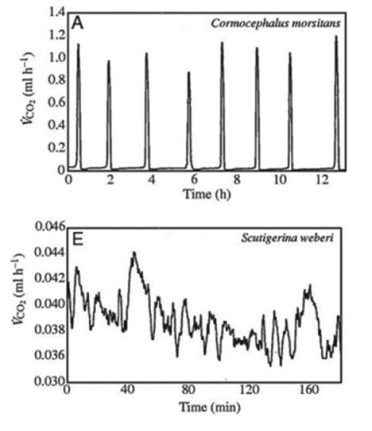Many terrestrial arthropods exchange gases with their environments by using tracheae, tubes that lead from openings (called spiracles) in the animal's exoskeleton or cuticle directly to the animal's tissues. Some arthropods can control whether their spiracles are opened or closed; opening the spiracles allows the carbon dioxide produced in the tissues to travel down the tracheae and be released outside the animal. Klok et al. measured the carbon dioxide emitted over time (represented by VCO₂) by several species of centipedes. The figures present graphs of their results for two species, Cormocephalus morsitans and Scutigerina weberi. (C. J. Klok, R. D. Mercer, and S. L. Chown. 2002. Discontinuous gas-exchange in centipedes and its convergent evolution in tracheated arthropods. Journal of Experimental Biology 205:1019-29.) Copyright 2002 The Company of Biologists and the Journal of Experimental Biology. 
Look at the graph for Scutigerina weberi (note the scale of the y-axis) in the figure.
-How would a terrestrial centipede most likely benefit from the ability to close its spiracles? Closing spiracles would ________.
Definitions:
Corn
A cereal plant (Zea mays) that produces large kernels on a cob; also used to refer to the kernels themselves, which are a staple food in many parts of the world.
Natural Ecosystems
Natural ecosystems are biological communities that interact with their physical environment, functioning through naturally occurring processes without significant human intervention.
Dead Organic Material
Non-living plant and animal matter that has not yet decayed, providing nutrients and energy sources for decomposers in ecosystems.
Recycle
The process of collecting and processing materials that would otherwise be thrown away as trash and turning them into new products.
Q1: Refer to the study by Poulsen et
Q4: The apoplast in plant tissues consists of
Q12: Suppose that the cells of seed plants,
Q38: Proposed Number of Hox Genes in
Q45: The opening of stomata is thought to
Q48: Leaf-cutter ants harvest plant leaves and bring
Q52: Which of the following characteristics allowed early
Q58: You find a multi-legged animal in your
Q65: In individual insects of some species, whole
Q78: The shell of a fertilised animal egg